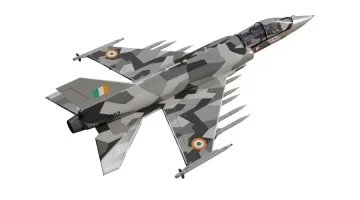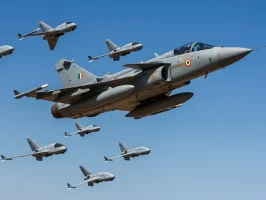- Views: 2K
- Replies: 9
State-owned aerospace and defence company Hindustan Aeronautics Limited (HAL) has released new concept images of its Hindustan Lead-in Fighter Trainer (HLFT-42), showcasing a formidable weapons configuration.
The visuals reveal the advanced trainer jet armed with ten Beyond Visual Range Air-to-Air Missiles (BVR-AAMs) and two wingtip-mounted Close Combat Missiles (CCMs), signalling a strong focus on its secondary combat role.
The HLFT-42 is a next-generation supersonic aircraft designed to provide a seamless transition for pilots graduating to advanced frontline fighters.
The concept, which was first officially presented as a scale model at Aero India 2023, is a critical component of India's strategy to achieve self-reliance in aerospace and defence technology.
Development of the platform is currently in a phase of design refinement based on detailed feedback from the Indian Air Force (IAF).
Engineered as a dual-role aircraft, the HLFT-42 combines the functionalities of an advanced trainer with those of a light fighter.
The aircraft features a total of 11 hardpoints—six under the wings, three under the fuselage, and two at the wingtips—capable of carrying a weapons payload of up to 5,000 kg.
This capacity allows for a versatile mix of armaments, including the potential integration of indigenous missile systems like the Astra BVR-AAM series and the future New-Generation Close Combat Missile (NG-CCM).
The primary purpose of the HLFT-42 is to bridge the training gap between basic trainers, such as the HAL HTT-40, and complex 4.5 and 5th-generation fighters like the HAL Tejas Mk2 and the upcoming HAL Advanced Medium Combat Aircraft (AMCA).
It is slated to replace the IAF's ageing fleet of BAE Hawk Mk132 trainers.
The aircraft will be equipped with modern avionics, a digital fly-by-wire system, and an Active Electronically Scanned Array (AESA) radar, preparing pilots for the sophisticated systems they will operate in frontline squadrons.
Beyond its training capabilities, the aircraft’s robust design allows it to perform in active combat scenarios.
Its significant payload and advanced sensor suite will enable it to undertake both air-to-air and air-to-ground missions, serving as a cost-effective force multiplier.
This dual-role capability is a key feature, providing the IAF with a flexible platform for various operational needs, from peacetime training to deployment in low-intensity conflicts.
The HLFT-42 project also holds considerable potential for exports.
The global market for military trainer aircraft is projected to reach $21 billion by 2033, driven by fleet modernisation and the need to train pilots for increasingly complex aircraft.
With its blend of advanced training features and combat capability, the HLFT-42 could be an attractive option for nations seeking affordable and versatile fighter-trainer platforms, positioning India as a significant competitor in the international aerospace market.
While still in the development phase, the project is moving forward, with HAL having issued a Request for Information (RFI) to global vendors for a suitable engine. The final selection of the powerplant and other key systems will be crucial in defining the aircraft's performance and timeline for induction.
Continued collaboration between HAL and the IAF will be essential to ensure the HLFT-42 meets the future requirements of India's air defence.


